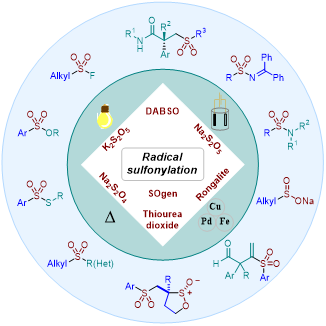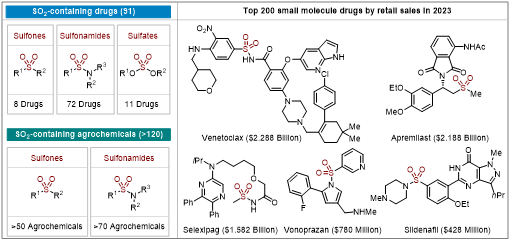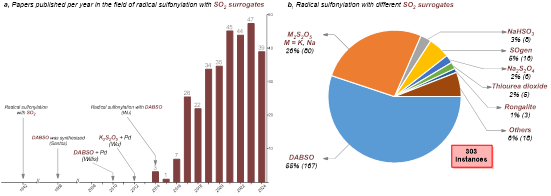Professor Wu Jie’s team from the School of Pharmaceutical and Chemical Engineering/Advanced Research Institute was recently invited to publish a review article online in Chemical Society Reviews (Impact Factor: 40.4) titled “Radical Sulfonylation with Sulfur Dioxide Surrogates” (Chem. Soc. Rev., 2025, 54, DOI: 10.1039/d4cs01312c). This article is the first from Taizhou University to be published in this journal. Dr. Xiao Wei is the first author, and Associate Professor Chen Jianqiang is a co-corresponding author.

Sulfur dioxide (SO₂) is one of the main atmospheric pollutants, with an annual emission reaching up to 100 million tons (Environ. Sci. Technol., 2020, 54, 6508). SO₂ emissions lead to severe environmental and public health issues. Common desulfurization methods include limestone absorption, organic solvent absorption, activated carbon absorption, and reductive desulfurization. However, these strategies often generate significant secondary pollutants.
From the perspectives of sustainable development and green chemistry, developing simple and efficient methods for SO₂ capture is of great importance. SO₂ is an important sulfur source widely used in the synthesis of sulfonyl-containing compounds. Currently, 91 marketed drug molecules contain the -SO₂- (sulfonyl) structure, and over 120 pesticides contain the -SO₂- structure. Therefore, utilizing SO₂ in organic synthesis and drug synthesis holds significant academic and market value. However, the application of gaseous SO₂ has many drawbacks, greatly limiting its use in synthesis.

To address this, chemists have developed a series of SO₂ surrogates. Common SO₂ surrogates include the organic surrogate DABSO, developed by the Willis group in 2010 (J. Am. Chem. Soc., 2010, 132, 16372), and the inorganic surrogate metabisulfite, developed by Professor Wu Jie’s group in 2012 (Chem. Commun., 2012, 48, 10037). Due to the electrophilic nature of SO₂, early SO₂ reactions primarily involved organometallic reagents for the synthesis of sulfones. Subsequently, transition-metal-catalyzed coupling reactions were gradually developed. In 2014, Professor Wu Jie’s group pioneered an SO₂ insertion strategy based on radical reactions (Angew. Chem., Int. Ed., 2014, 53, 2451). Since then, radical reactions involving SO₂ have gradually emerged, related research has flourished, and it has become a hot topic.
This review systematically introduces the development status of various SO₂ surrogates. It is subdivided into four sections based on the method of radical generation: photocatalysis, electrochemical synthesis, transition metal catalysis, and thermally initiated radical sulfonylation, providing a comprehensive overview of radical sulfonylation reactions involving SO₂.

Article link: https://pubs.rsc.org/en/content/articlelanding/2025/cs/d4cs01312c
Dr. Xiao Wei has published 19 papers as first author or corresponding author in journals including Chem. Soc. Rev., ACS Catal., Sci. China Chem., Org. Lett., and Org. Chem. Front since joining Taizhou University in 2019.
Associate Professor Chen Jianqiang has published 23 papers as first author or corresponding author in journals including Nat. Commun., Chem. Soc. Rev., Green Chem., Org. Lett., and Org. Chem. Front. since joining Taizhou University in 2019.